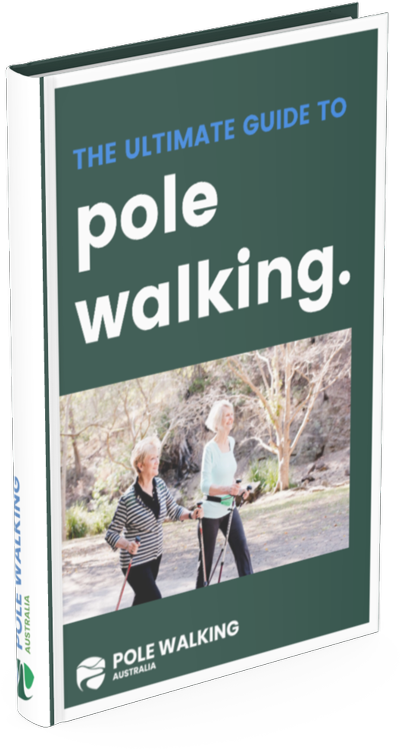The complete Guide to Strapless Nordic Walking in Australia

What is Nordic Walking (NW)?
Simply stated, Nordic walking is walking with the addition of poles to increase your energy output and “power up” your walk. However, there is a little more to it once you scratch the surface.
Nordic walking as we know it now began in Finland the 1990’s when specialised poles were first developed to be used purely as an addition to walking, rather than a cross country ski training activity. Since then, several companies worldwide have manufactured and adapted the original “half gloved” or strapless version to improve, simplify or modify the technique and benefits.
The one thing that sets all Nordic walking apart and is common to all types of techniques and poles is that it uses an opposite arm to leg, rhythmic placement of the poles. Although this looks simple, and is a habitual activity once you get to work on it, it may take some time to learn to coordinate the upper and lower body, and use the poles to their full advantage.
What is strapless Nordic walking?
Fast forward to Vancouver in 2004, when an Occupational Therapist, Mandy Shintani, learnt to Nordic walk from her Swedish neighbour. At the time, Mandy was completing her Masters in Gerontology and she immediately saw the benefits of using poles for the people who therapists work with. Urban Poling, the company was formed and is now the Canada’s leading Nordic walking pole manufacturer and distributer, having trained and certified over 3000 instructors and therapists in several countries.
After researching different types of poles and Nordic walking, Mandy chose a strapless method and developed a strapless, ergonomic handgrip because it lends itself to a simple and safe walking technique while emphasising the use of the abdominal “core” when walking. The basic technique is the same upper and lower alternate movement but does not require the arm to swing behind the hip, as in strapped Nordic walking. There is no need to learn the rythmic opening and closing of the hand which requires more coordination than a strapless technique. The hand rests on a ledge and remains lightly closed throughout the entire walk.
Is Nordic walking better than walking?
Nordic walking is walking with the addition of the upper limb and back, so it supercharges your walk, as we like to say! Here are some great benefits to using poles when walking:
- It uses 90+% of the body’s muscles, as opposed to only the lower limb muscles. The extra muscles include upper back, triceps, pecs, and abdominal core muscles.
- It strengthens and tones your trunk, core and upper arm
- It improves posture by targeting the upper back muscles
- It burns an average of 20% more energy than standard walking
Places to do Nordic walking
Remember that Nordic walking is easy once mastered but requires some concentration and instruction to start out. Where you walk can make the difference between frustration or confidence, will help you get going more quickly, and challenge you to work harder.
At first, you will need to work on your technique until it is second nature, and you no longer have to think about it. Where you walk will greatly help with this. Start out on a wide, flat, and smooth concrete path. Do not start on gravel if you can help it as the poles are more likely to slip. Make sure you can see at least 10 meters in front of you, and the path doesn’t have any sharp corners to negotiate. Finally, stay away from overly busy paths or times of the day as you don’t want to be avoiding runners or cyclists too often.
When you have gotten the opposite arm to leg technique, with a long arm swing, you can either stay on your nice wide path, and enjoy a nice leisurely walk or work towards increasing your push and speed. Alternatively, you can change your walk route and look for more challenging terrain like hills or the bush.
Hills require a slightly different technique, and will use more effort. However, they are much easier to climb with poles than without, and poles also provide more stability when going down. With hills, the important thing to remember is to keep the poles closer to your body and elbows bent, rather than straight. When going downhill, do not push yourself down but control your speed by keeping the poles at the level of, or slightly in front of the foot when you place it. For more information on hills, check out Pole Walking Australia on YouTube, or work with an instructor.
You can also challenge yourself by going off road and trying different surfaces like grass, or bush tracks. Pole Walking Australia has trekking tips for bush walking and hiking. If you don’t have trekking tips, always take your rubber boot shaped (or bell shaped) tips with you, even if you don’t use them. This is because, on a more rocky or hard surfaces, rubber tips provide you with a firmer grip. Smaller carbon tips may cause slippage in this kind of terrain and are better used when in muddy or slippery soil conditions.
What are the best Nordic walking poles?
Nordic walking is a unique form of exercise, and, like all sports and exercise modalities, requires specialized equipment. You will hear the common refrain among Nordic walking instructors that “all poles are not equal”. When choosing poles to walk with, you will be faced with endless options, and the decision-making process can be quite confusing. Therefore, knowledgeable advice by an instructor is essential to help you avoid costly and possibly dangerous mistakes.
One thing to remember is that you generally get what you pay for. Like many types of sporting equipment, there is the very cheap, the mid-range, and expensive equipment. The more expensive the equipment, the more “bells and whistles” but generally, mid-priced poles will suit most people.
Essential features to look for in Nordic walking poles include: adjustable poles, which are good for travelling and also to enable changes in technique as you improve; boot shaped tips (sometimes called “paws”), which prevent clacking on pavements, and provide shock absorption; an easy and secure mechanism for adjusting the poles; and correct and fitting hand straps, if using a strapped method for Nordic walking.
There are a few less obvious features which are important when choosing your poles. Check the weight limits. Some poles will take as little weight as 10-20 kg so can be prone to collapsing. The strength of the poles can affect the longevity of them. Be careful with very light poles, which can be flimsy. Poles should be of a good material such as aircraft grade aluminium. Finally, anti-vibration features such as mid pole ferrules and absorbent rubber hand grip ledges and boots will make the whole experience of Nordic walking much more comfortable and often quieter.
Can I use a trekking pole for Nordic walking?
Many people think that hiking poles are fine when Nordic walking. However, this is not the case. There are many different manufacturers, instructors and users of Nordic walking in nearly every country of the world now. The one thing that they all agree on is that trekking poles should not be used for Nordic walking.
Different purposes require different types of equipment. For example, ball sports such as soccer, rugby union and volleyball all use a ball, but you would never think of using a volleyball to play rugby union with. The shape, size and way it is used differs from one ball game to another, depending on whether the ball is hit, kicked, or passed. Nordic walking is different to hiking and so different poles are used in order to gain the best advantage when walking with them. Let us look a little more closely at the purposes of poles.
Hiking poles are made for steadying or assisting a person when going up or downhill. They are not designed for Nordic walking, which is all about rhythmic exercise and speed. Hiking poles have a single strap for convenience, and small rubber tips, if any, that cover the short spikes at the bottom. Hiking pole straps do not allow the pole to be used for propulsion. To Nordic walk with hiking pole, you need to grip very tightly, and over a longer period, this can lead to discomfort, hand pain, numbness or cramping.
Classical Nordic walking poles have a thin handle and half-glove-like straps and are designed to hold the person to the pole. Because they were originally developed as a fitness and speed enhancing pole, they are designed to be used with an open/closed hand technique which allows the user to push their hand right back behind the body. They are often used in Nordic walk racing.
Strapless Nordic walking poles such as Urban Poles, have a comfortable ergonomic hand grip with a ledge at the bottom, this ledge allows the hand to push the pole down and back so the person using it still propels it, but doesn’t have to worry about the more complex technique of opening and closing the hand.
Nordic walking technique (Strapless)
The technique of Nordic walking is simple once learned but can take a while to master when first using them. The basic technique is a rhythmic opposite hand to foot march with poles placed and propelling at each step. There are 4 main steps as follows for using strapless poles, which are the easiest to manage:
- Hold your poles so they drag behind you with your arms by your sides. Relax your arms and you will probably notice that the opposite arm and leg move together.
- Step a little longer and swing your arms up a little higher to a handshake-height position. Your arms should be swinging from the shoulders and should stay comfortably straight. You may need to stay on this step for a while until you get the opposite arm and leg working together. If you get out of sync, just stop and start from step 1 again.
- When you feel confident with the opposite arm to leg action, press down firmly when you reach the top of your arm swing, and keep the pressure on until you get back to your hip. You will feel your step lengthen a little and your speed increase slightly. Don’t worry about lifting the poles yet, although they may do so without you trying.
- The last step is a slight lift as you bring the poles forward. You will go from a “drag, drag” feel and sound, to a “tap,tap” one.
Note that at all times the pole is held behind. You should never see them in front of your feet.
So all that remains now is to find an instructor, get some poles, a couple of mates, and start walking. What are you waiting for?


